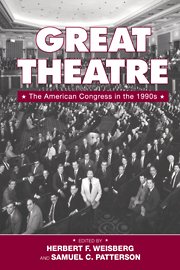Book contents
- Frontmatter
- Contents
- Figures and Tables
- Preface
- Contributors
- Introduction
- Congress and Its Audience
- Congress at Play
- Congress and Other Actors
- 8 The Plot Thickens: Congress and the President
- 9 Congress and the Courts: A Case of Casting
- 10 Behind the Scenes: The Supreme Court and Congress in Statutory Interpretation
- 11 Congress and Foreign Policy: A Neglected Stage
- Conclusion
- References
- Index
8 - The Plot Thickens: Congress and the President
Published online by Cambridge University Press: 20 January 2010
- Frontmatter
- Contents
- Figures and Tables
- Preface
- Contributors
- Introduction
- Congress and Its Audience
- Congress at Play
- Congress and Other Actors
- 8 The Plot Thickens: Congress and the President
- 9 Congress and the Courts: A Case of Casting
- 10 Behind the Scenes: The Supreme Court and Congress in Statutory Interpretation
- 11 Congress and Foreign Policy: A Neglected Stage
- Conclusion
- References
- Index
Summary
The “read my lips” budget battle of 1990, the contest over the nomination of Justice Clarence Thomas, the conflict over whether to send troops to Saudi Arabia prior to the Gulf War, the struggle to enact Bill Clinton's economic program in 1993, health care warfare in 1994, the fight over the Republicans' budget in 1995 – a series of high-visibility showdowns between the president and Congress captures much of the history of the relationship between the two branches in the 1990s. Has the relationship between Congress and the president changed in a major way? Is it more conflictual and more prone to result in gridlock in the 1990s– and if so, why?
In this chapter I argue that many of the basic factors that determine the character of that relationship have not changed; however, trends with pre-i99os origins have reached a point and have combined in such a way as to alter that relationship significantly. Partisan and ideological polarization and the suffusion of the political arena by media with a negative bias and a voracious appetite for conflict lead to a more conflictual relationship between the president and the Congress and also result in that relationship, which at least since Teddy Roosevelt's time has included a considerable element of theatre, now being predominantly played out on the public stage, with audience reactions determining who wins and who loses.
Understanding what has happened and why requires first understanding the determinants of presidential–congressional relationships in general.
- Type
- Chapter
- Information
- Great TheatreThe American Congress in the 1990s, pp. 175 - 196Publisher: Cambridge University PressPrint publication year: 1998

